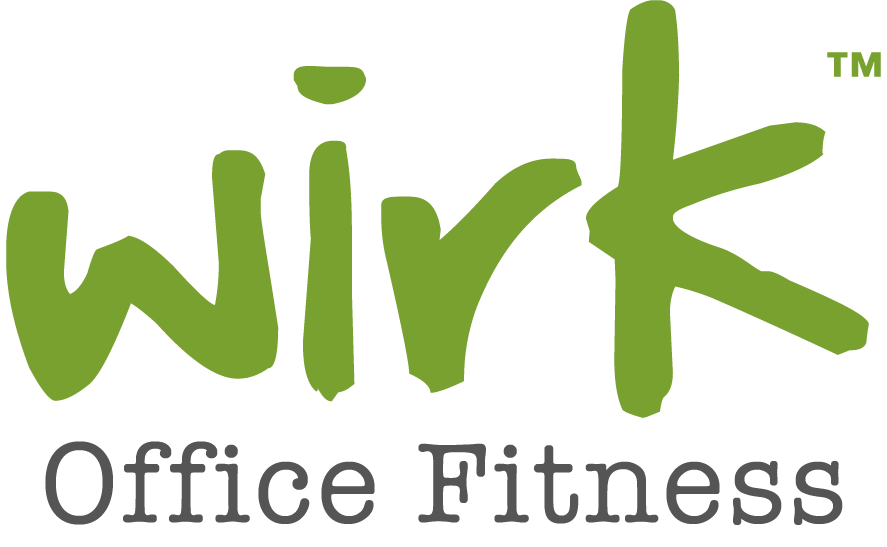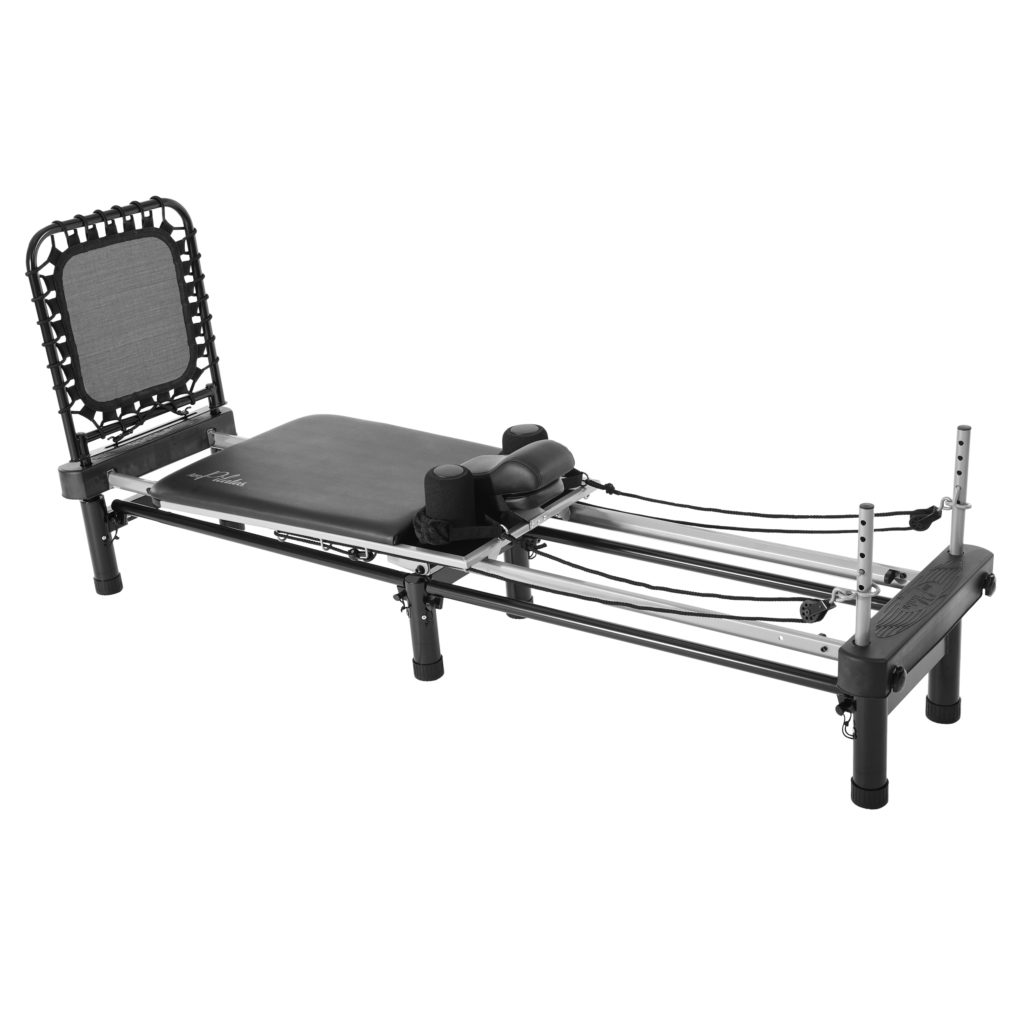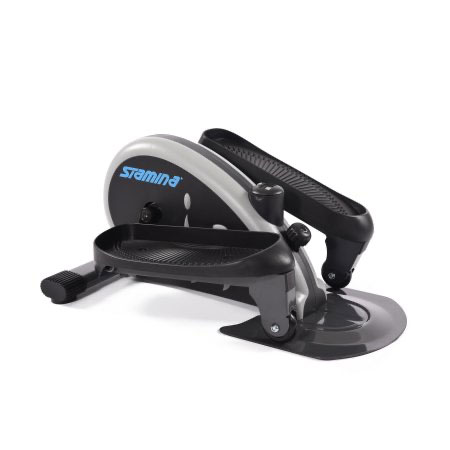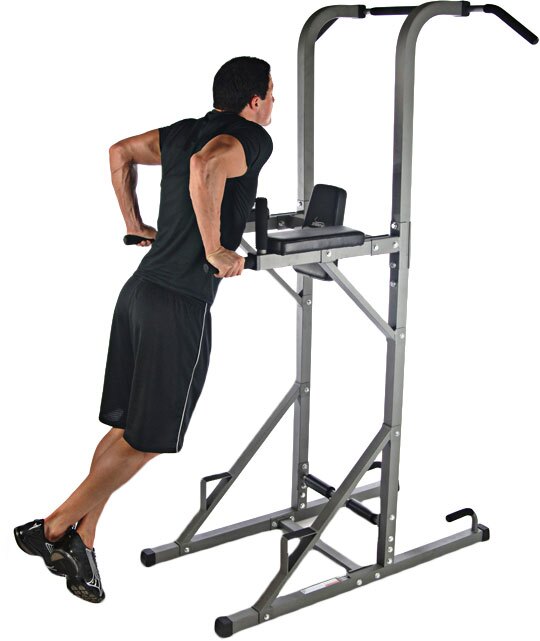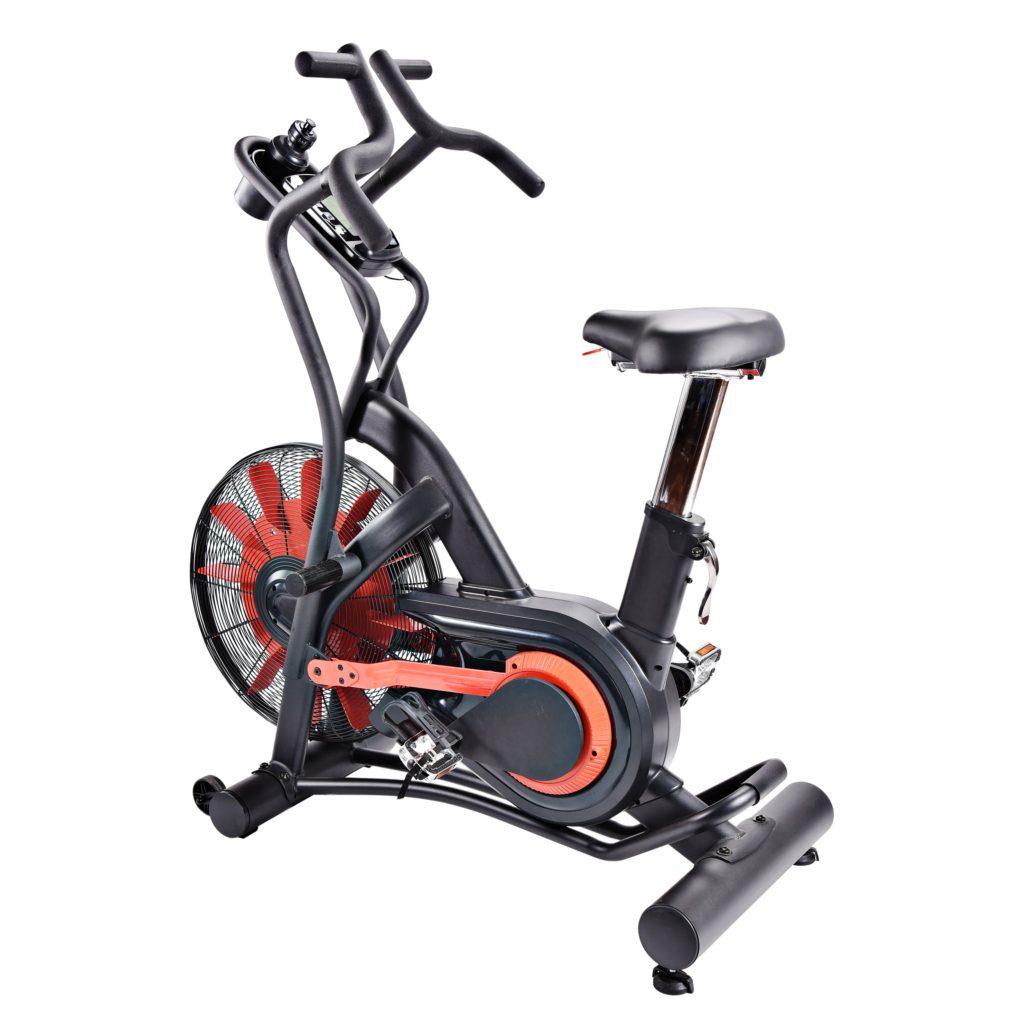Guide to Managing Lower Back Pain: Stretches for Back Pain Prevention
A healthy lower back and spine help you move through life without pain and frustration. As you age, your risk for back problems increases. If you perform repetitive motions, lift heavy objects frequently or sit at a desk all day, you may experience upper or lower back pain regardless of your age.
How can you get relief or avoid severe back pain altogether? Strengthening your back muscles and stretching helps prevent back pain. While back pain exercises alleviate stiffness and tension, they also help you maintain mobility and reduce stress on the spine.
This guide includes:
- statistics about back pain
- common causes of back pain
- stretches for back pain prevention and relief
- and recommendations for back health equipment.
Improve your back health and get back to life—and all the things you enjoy!
How Many People Have Back Pain?
The most common type of pain is back pain. Experts suggest that 80% of the population experiences back pain at some point in their lifetimes. Back pain is the leading cause of missed work days. Approximately 264 million work days are lost each year because of back problems.
People living with back pain every day report feeling sad or hopeless more often than those without back pain. Managing back pain is more than a physical need. It takes a toll on mental health when you are uncomfortable and unable to do the things you love.
What Kind of Back Pain Do I Have?
There are two types of back pain: acute and chronic. Pain that lasts a few days or weeks is considered acute. Eventually, acute pain will go away on its own. Chronic pain is pain that lasts more than 12 weeks.
The lower back is where most back pain occurs because the lumbar region of your spine supports much of your upper body weight. Back pain ranges in intensity from dull aches to sharp, shooting pains.
Ouch! Common Back Pain Causes
What causes back pain? You may notice your back flare up after a hard day’s work or feel stiff after too many hours in front of the computer. Intense or persistent pain may be signs of a larger health problem. You should consult a doctor if pain persists or renders you unable to move.
Common back pain causes include:
- Scoliosis and other skeletal irregularities
- Sprains from overstretched ligaments
- Strains or tears in tendons
- Herniated disks
- Nerve inflammation
Back pain usually begins between the ages of 30 and 50 as intervertebral disks lose fluid and decrease their support between vertebrae. While some back pain may be genetic, upper and lower back pain can be caused by your job. Heavy lifting and repetitive twisting can lead to injury or pain. Poor posture and support from sitting all day can also cause pain.
The Good Stuff: Stellar Back Pain Stretches
What can you do to relieve lower back pain? Will exercise help? Does stretching help lower back pain?
When you live with back pain, simple exercises can help reduce tension and improve your range of motion. Try these stretches to relieve your back pain.
You can perform the following back pain exercises at home without any equipment. The American College of Sports Medicine recommends holding static stretches for 10 to 30 seconds and stretching two to three times a week. Stretching daily is most effective.
Before you begin, remember to move slowly and carefully. Quick movements or bouncing could exacerbate your pain. Stretching shouldn’t be painful. If an exercise hurts, please stop immediately. As always, consult your doctor before starting new activities.

Bridge Exercises
Bridge exercises help relieve back pain and strengthen your core. Strong abdominals and back muscles make for a stable trunk, preventing you from making awkward movements that could strain or harm your back. Doing these exercises regularly also tones your glutes, which helps improve posture.
There are multiple ways to perform bridge exercises. Here are two common methods: the prone bridge and the supine bridge.
Prone Bridge (AKA The Plank)
The plank is a version of a bridge exercise. It’s been proven to increase trunk muscle thickness, which helps stabilize the back and improve posture.
- Start with your hands and knees on the ground.
- Place your forearms on the floor.
- Walk your feet out and hold yourself up using your toes and forearms.
- Keep your elbows at 90 degrees and your eyes facing forward.
- Hold for 30 seconds at a time.
Supine Bridge
The supine bridge is another way to engage your trunk muscles. Lifting the pelvis for this exercise may be too difficult for some people with lower back pain. Start slowly and work your way up to 30 repetitions of the supine bridge.
- Start by lying on your back with your knees bent.
- Keep your feet flat on the floor and hip-width apart.
- Keep your neck and shoulders relaxed and on the floor.
- Engage your abdominals and glutes. Use them to raise your hips until you form a line from your knee to your shoulders.
- Hold the position.
- Return to the start and repeat.

The Cat-Cow Pose
Add some yoga to your daily routine. A 2020 study published in PLOS One, a peer-reviewed scientific journal, suggests that yoga might help relieve short-term back pain. Other studies find that yoga may help improve back function in three to 12 months when compared to doing nothing at all.
The classic cat-cow yoga pose helps you destress and focus as you synchronize your breath with your movements. This standard pose also serves as a spinal cord strengthening exercise.
As you move, you’ll engage your tailbone and release tension in the upper body. These movements help strengthen your spine and improve circulation between your vertebrae with every repetition.
- Start with your hands and knees on the ground.
- Inhale and press into your hands and knees as you look up, letting your back and abdominal muscles sink toward the floor.
- Exhale and tuck your chin into your chest, arching your spine to the ceiling. It should feel like you are pulling your abdomen toward the ceiling.
- Repeat steps two and three with each breath.
- Continue for a few minutes.
- Try to repeat these movements three to five times.
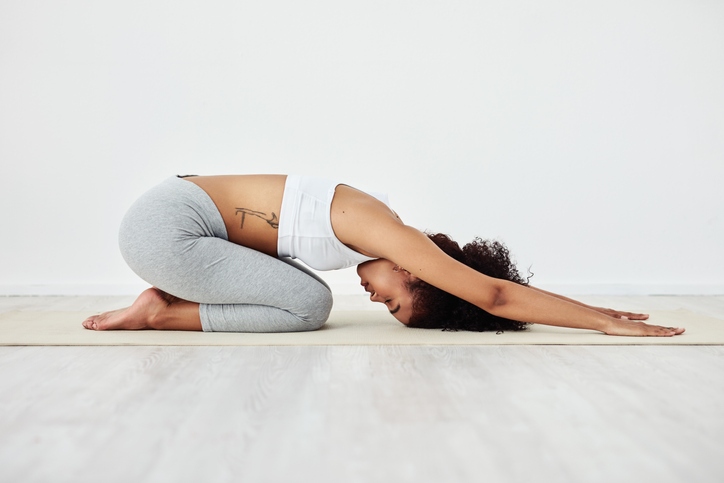
Child’s Pose
Relieve tension along your spine and find your zen in child’s pose. Stretch your lower back, thighs and glutes with this yoga move. Holding this pose releases tension in your neck and shoulders. You’ll feel the elongating stretch relax muscles down your spine.
- Begin with your hands and knees on the ground.
- Sink your hips back until they rest on your heels.
- Rest your stomach on your thighs.
- Extend your arms in front of you, resting your forehead on the ground.
- Hold the position for up to a minute while you focus on your breathing.
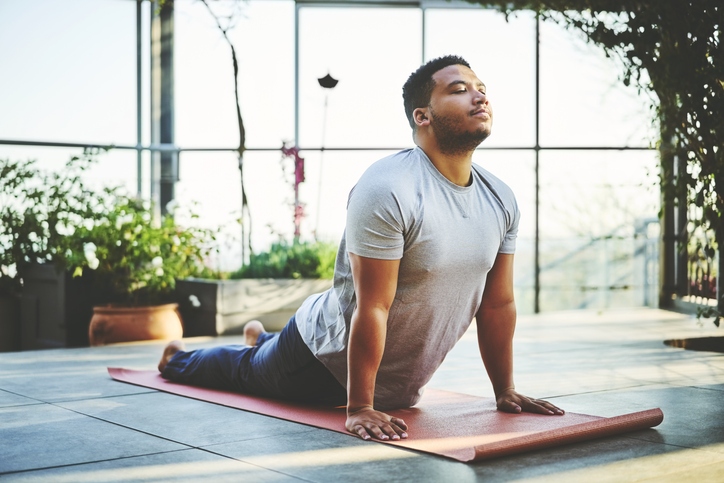
The Cobra
Embrace the movements of the mighty king cobra. The cobra pose stretches the muscles in your chest and shoulders while strengthening your arms and core.
What makes it a great exercise to prevent a bad back? The cobra pose releases tension and reduces stiffness. A study from the Medical Science Monitor found that doing yoga regularly, including stretches like the cobra pose and child’s pose, reduced the frequency of self-reported lower back pain.
Low Cobra Pose
During the low cobra pose, your stomach remains on the floor. This version of the pose may be easier to start with, especially if your back is tender. Try low cobra first and work your way toward full cobra.
- Lie on your stomach with your feet hip-width apart and toes pointed.
- Bend your elbows and place your hands near your ribs.
- Push up with your hands and rise as your chest leaves the floor. Your lower belly should remain on the floor, and your elbows should remain bent.
- Gaze forward or down toward your cheeks.
- Hold the pose here.
Full Cobra Pose
A more advanced version of the cobra pose lifts your belly off the floor completely. Full cobra offers more of a challenge as you hold your body up. You can push into full cobra directly from low cobra.
- Lie on your stomach with your feet hip-width apart and toes pointed.
- Bend your elbows and place your hands near your ribs.
- Push up and rise into the cobra pose until your arms are straight. Your chest and stomach should leave the floor.
- Gaze forward.
- Hold the pose.
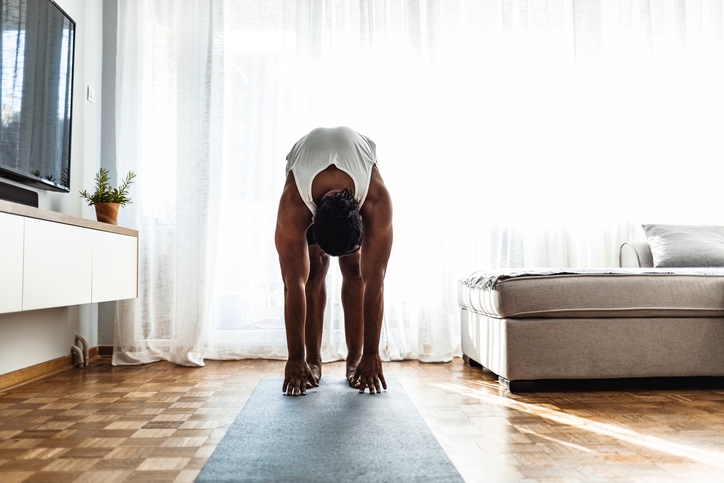
Hamstring Stretch
Back pain can be caused by other parts of the body. Tight hamstrings put stress on the lower back. These muscles tilt your pelvis back when tight, causing your back to flex forward. Stretching your hamstrings helps them relax and prevents them from pulling the pelvis back, relieving tension on your spine.
Standing Hamstring Stretch
- Stand with your feet hip-width apart.
- Bend forward and reach for your toes. Don’t force yourself to touch your toes. Just lean forward until you feel a pull in your hamstrings.
- Hold the position.
The standing hamstring stretch can exacerbate lumbar pain. If a standing hamstring is too hard, try a seated hamstring stretch or use a towel to aid your movements instead.
Seated Hamstring Stretch
- Sit on a chair.
- Place one leg out in front of you.
- Reach toward your toes. Don’t strain to reach your toes.
- Hold before repeating with the opposite leg forward.
Towel Hamstring Stretch
- Grab a towel and lie on your back.
- Put the towel behind your knee or calf.
- Pull the leg up toward you using both ends of the towel.
- Stop and hold when you feel the stretch.
- Repeat with the other side.
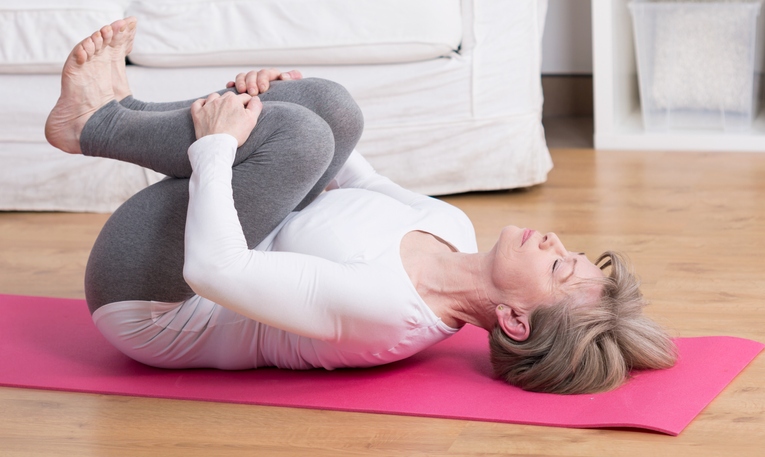
Knees-to-Chest
Knees-to-chest focuses on back flexibility. Many exercises have you bend at the hips or use your legs in addition to your back. Knees-to-chest keeps the legs and hips relaxed, letting your spine do all the flexing.
- Lie on your back with knees bent and feet flat on the floor.
- Bring one knee to your chest. Use both hands to hold it against you. Your hands can be behind the thigh or on top of your shin.
- Press your spine to the floor. Avoid lifting your hips.
- Hold this pose before returning the leg to the floor.
- Repeat with the opposite leg.
You can also perform knees-to-chest with both legs. Bring one leg up and then the other. Clasp your hands around both legs before focusing on your spine.
This is a great back pain prevention exercise to perform when you wake up and before you go to bed.

Piriformis Stretch
The piriformis is a small muscle located within the buttock. It connects your spine to your femur and is near your sciatic nerve. A tight, overworked or injured piriformis muscle can cause lower back pain.
- Begin by lying on your back with your knees bent and feet flat on the floor.
- Place your right foot at the base of your left thigh.
- Put your hands behind your left thigh.
- Pull your thigh toward your chest. Stop once you feel a stretch.
- Hold the position for five seconds at a time. Work your way up to a longer period of time.
- Perform the same actions using the opposite leg.
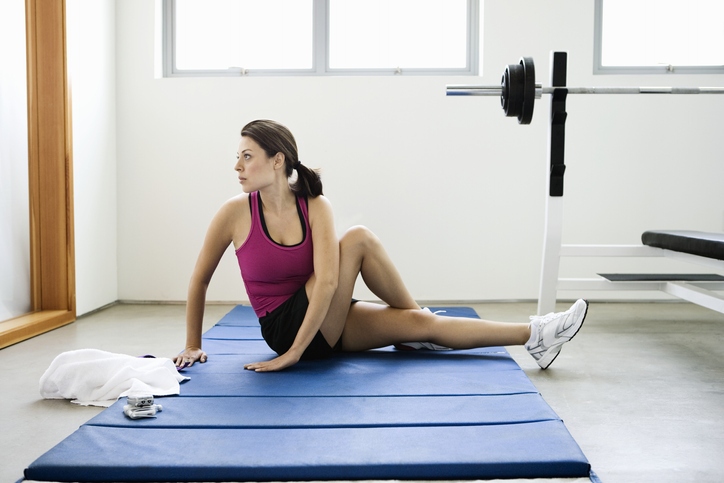
Seated Spinal Twist
Want better spine mobility? The seated spinal twist is a great example of how to stretch your lower back and spine. However, it can increase the risk of a herniated disk or injury for some. If you have chronic lower back pain, ask your doctor before trying twisting motions.
- Sit on the floor with both legs out in front of you.
- Bend your left knee and place the foot outside of the opposite thigh.
- Place your right arm on the outside of your left thigh. Leave your left hand behind you for support.
- Slowly twist to the left side. Focus on the base of your spine.
- Hold the pose.
- Repeat on the other side.
You can also perform this stretch in an armless chair or lying down. If you use a chair, cross one leg over the other and place your elbow outside the opposite knee. For a supine spinal twist, lie down and bring your knees to one side of your body. Hold the pose before bringing your knees to the opposite side.
Exercise Equipment for Better Back Health
You can perform many back health exercises from home without equipment. For those looking for tools to help, equipment can enhance your experience and aid in relieving your pain.
Are you looking for exercise equipment for back pain? Do you want better mobility? If you’re ready to improve your back health, Stamina Products offers an exceptional line of back health products made to loosen, decompress and massage muscles.
Back health equipment may look intimidating. Stamina Products designs every piece to be comfortable, easy to use and simple to control, whether you’re living with back pain every day or you want to prevent back pain in the future.
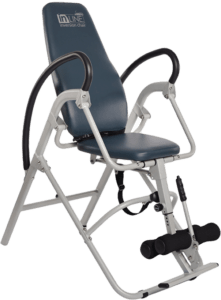
Stamina Inline Inversion Chair
The Stamina Inline Inversion Chair uses your weight to decompress your spine. We know inversion can feel precarious. Our inversion chair comes with many security features to keep you in place while inverted.

Stamina Active Aging EasyDecompress
Decompress your lumbar spine from your home or office. The simple Active Aging EasyDecompress offers a partial range of motion to give you more control.

Inline Traction Control System
If inverting isn’t for you, get relief from middle and lower back pain with the Inline Traction Control System. You can stretch while your feet remain on the floor, making this piece of equipment better for those with high blood pressure.
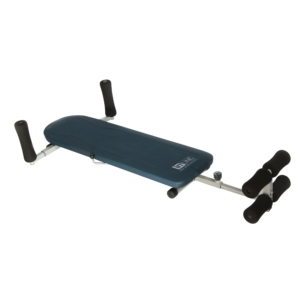
Inline Back Stretch Bench
The Inline Back Stretch Bench and Inline Back Stretch Bench Pro loosen tight muscles through decompression and at-home traction therapy, releasing tension from the spine, hips and knees.

BackTrac Back Massager
Get an at-home self-massage with the BackTrac Back Massager. It applies acupressure to reduce tenderness and deep massage to improve muscle function. The BackTrac is for people who want to aggressively treat their back pain.
Shop all back health products and get back to your life today.




